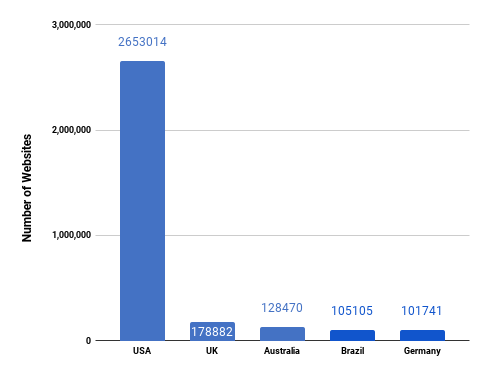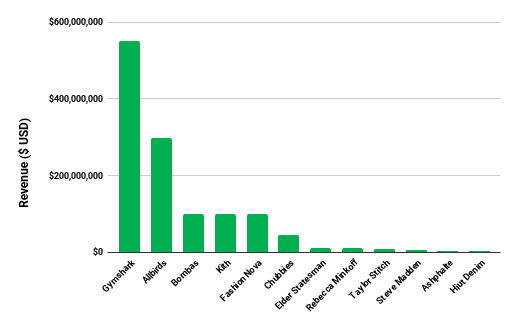A global eCommerce giant that powers some of the biggest brands in the industry, Shopify has been making online shopping easily accessible since 2006. Today, the platform is a global favourite with merchants and shoppers, and there are almost 5 million active Shopify websites online.
A quick glance at some of the most impressive statistics reveals:
- In 2023, Shopify powered 4,889,380 live websites.
- Shopify experienced 201.53% growth between March 2020 and January 2022.
- Shopify is set to reach 2.14 billion users by the end of 2023.
- On Black Friday Cyber Monday weekend in 2023, Shopify stores made $9.3 billion in sales.
- Shopify is one of the top ten SaaS companies globally.
- Apparel holds the most market share, with more than 500,000 active stores online.
- Gymshark tops the revenue list, making $550 million annually.
- 79% of Shopify customers use their mobile phones to make purchases.
From tiny startups to enterprises like Tesla, LVMH, Kylie Cosmetics, and Red Bull, Shopify offers merchant solutions that are easy to integrate, user-friendly, and cost-effective. To highlight just how much of an impact this platform has on the ecommerce industry, we’ve taken a closer look at some of the key Shopify statistics for 2023 and the trends and figures predicted for 2024.
Shopify Sites & Users By Numbers
Shopify is now one of the biggest SaaS (software as a service) companies in the world, and it’s right up there with Salesforce, Adobe and Intuit, who take the top three spots. As the software facilitates everything from marketing and payments to shipping, it’s no surprise that the platform is a favourite with merchants and users globally.
Over the years, the number of merchants and users has swelled impressively and in 2023, there are more than 2.1 million daily active users spread across Shopify’s 4,889,380 live websites.
When Shopify first went live, it catered predominantly to English-speaking countries, and initially, it only supported the US dollar. Although the platform now supports 21 languages and 11 currencies, there’s still a ripple effect from its English-centric origins, and the platform remains most popular in English-speaking countries.
In 2023, the top five countries using Shopify were as follows:

- USA (2,653,014 websites)
- UK (178,882 websites)
- Australia (128,470 websites)
- Brazil (105,105 websites)
- Germany (101,741 websites)
In the US, Shopify is the biggest name in eCommerce software and by June 2023, 28% of US websites with ecommerce facilities were powered by the platform. Its biggest competitors are Squarespace, WooCommerce and Wix, all of which have a market share of around 14% – half of what Shopify has.
In the UK, Shopify enjoyed a 41% Year-Over-Year increase in stores in Q3, and the platform currently holds 21% of the market share. WooCommerce is, however, currently in the lead with 22% of the market share, so it’s a very thin line between first and second place. The majority of Shopify merchants are located in England, with 153,265 stores based there. Scotland follows with 8,377, then Wales with 4,759.
As the number of stores continues to grow, so do the user numbers. In 2022, 649 million people made a purchase from a Shopify store. By 2023, this number was over 700 million, and by the start of 2024, it’s predicted that 2.14 billion users will have used the platform to make a purchase.
Tracking customer growth over the last five years, it’s easy to see that the pandemic years of 2020 and 2021 had a major impact on buyer numbers but that the platform certainly hasn’t hit a plateau yet.

- 2019: 300 million buyers
- 2020: 457 million buyers
- 2021: 572 million buyers
- 2022: 649 million buyers
- 2023: 700 million buyers
The Most Popular Shopify Businesses
You can find a Shopify site selling just about anything these days, but in 2023, fashion businesses are in the lead. According to Statista, in June 2003, there were more than 500,000 online apparel stores using the ecommerce platform.
Coming in second was Home and Garden, with around 220,000 stores, followed by Beauty and Fitness at 186,706 stores. Food and Drink were next with 116,008 stores and People and Society with 68,801. In sixth place were Sports with 62,669 stores, with Health and Art and Entertainment just behind at 61,983 and 61,283 respectively. The ninth and tenth spots belong to Toys and Hobbies and Pets and Animals, with store numbers reaching 53,082 and 40,609.
With between 36,000 and 30,000 stores were Autos and Vehicles, Gifts and Special Events, Consumer Electronics, and Business and Industrial. Computers surprisingly only have 28,878 stores, and Games around half that number at 14,449. In the bottom three are Books and Literature, Jobs and Education, and Travel, with 12,154, 10,642, and 8,878 stores each.
To get an idea of the revenues that the top fashion stores on Shopify earn, we’ve listed the twelve biggest earners, their location, annual revenue and the type of apparel they sell:

- Gymshark: (US) $550 million, Fitness Apparel
- Allbirds: (US) $298+ million, Footwear
- Bombas: (US) $100 million, Clothing
- Kith: (US) $100 million, Fashion
- Fashion Nova: (US) $100 million, Fashion
- Chubbies (US): $44 million, Clothing
- Elder Statesman: (US) $11 million, Clothing
- Rebecca Minkoff: (US) $10 million, Fashion
- Taylor Stitch: (US) Between $5 and $7 million, Clothing
- Steve Madden (US) $5+ million, Fashion
- Ashphalte: (France) $3+ million, Clothing
- Hiut Denim: (UK) $2 million, Clothing
When it comes to choosing a Shopify platform, overall, Shopify Plus stores have the highest revenue share, with sales revenues ranging between $1 million to $500 million in 2023. However, as the Plus platform is designed for high growth merchants and brands with more revenue, this is not unexpected. More than 13,000 merchants currently use Shopify Plus, and almost 1,000 of those are based in the UK. Although Shopify Plus was launched in 2014, it really took off in the early 2020s as the demand for enterprise solutions grew due to the increase in people shopping online.
Shopify Shopping Trends
The way that shoppers shop online plays a huge role in the success of Shopify, and the platform continually improves and upgrades its offering to ensure it accommodates current buyer trends and behaviour.
In 2023, 79% of Shopify traffic came from mobile devices, proving that mobile is now way ahead of desktop use when it comes to shopping online. Fortunately, it’s now easy for merchants to convert their existing Shopify store into an app that users can download. This ensures that merchants can easily cater to the demand for mobile-optimised content and reach customers on the go.
However, for all the sales that are made on Shopify, abandoned carts are still an issue for many merchants. Research from Baymard shows that a whopping 70% of orders never make it to checkout, and on mobile devices, this jumps to 85%+. The top reasons for abandoned carts are extra costs being too high (shipping, taxes, etc.), having to create an account before completing the transaction, delivery being too slow, or customers not trusting a site with their credit card details. Other reasons included unsatisfactory returns policies, website issues, complicated checkout processes and too few payment methods.
In terms of when Shopify is the busiest, it’s no surprise that Black Friday and Cyber Monday both bring in sales. In 2022, Shopify set a record by making $7.5 billion in sales over the Black Friday Cyber Monday (BFCM) weekend. In the UK, high street and in-person shopping also got a major boost, with a 24% increase, and mobile shopping got a whopping 75% boost, with desktop sales lagging but still enjoying a 25% increase. But in 2023, they topped this, racking up an incredible $9.3 billion in sales overall over the BFCM weekend, breaking the previous record by 24%.
Platforms powered by Shopify also benefit more from repeat shoppers than first-time buyers. With the cost of customer acquisition 60% higher than it was five years ago, repeat customers are ecommerce gold. Customers who place more than one order online can generate as much as 300% more revenue for a store, and while these repeat shoppers may only make up around 21% of a brand’s customer base, they account for as much as 44% of all revenue.
Marketing Trends That Make A Difference
When it comes to marketing, there are also some trends that stood out in 2023 and look set to make an impact in 2024.
One of these is the use of live chat. Research shows that proactive live chat can boost the average order value by between 10 and 15%, and it can increase a brand’s revenue by around 13%, too, making it a worthwhile addition. Customers love it when a store can reach out and provide information, answer questions, give discounts and share recommendations. Personalisation has become a huge marketing tool in the last few years, and live chat ticks this box perfectly.
To reach customers and achieve conversions, gold old-fashioned email is the preferred option as it’s the best place to reach customers. Email campaigns have the highest conversion rates, with a 4.29% average. This beat search, direct and social media marketing, which have the following conversion rates:
- Search: 3.04% conversion rate
- Direct: 2.93% conversion rate
- Social media: 1.81% conversion rate
Influencers have also played a major role in marketing for Shopify stores, and with the influencer market predicted to be worth $143 billion by 2030, this trend is likely to continue. According to Shopify, more than half of the brands running stores work with influencers, and 36% of stores say that influencer content outperforms branded content.
Leading on from influencers is social commerce, which is already having a major impact on the way Shopify stores drive sales. With features like Facebook Commerce, Instagram Checkout, and TikTok Shopping, users can make purchases directly from social platforms. Shopify pinpointed this as a major emerging trend in 2023, and in 2024, it’s only going to get bigger.
2024 Shopify Predictions
With sales on the rise, the number of stores increasing every year, and NASDAQ predicting better stock growth in 2024, Shopify is riding the wave of success. Much of this success is driven by the ability to meet customer demand, adapt, and evolve, and these are the trends predicted to facilitate change in 2024:
Same Day Delivery:
Research reveals that there’s been a 23% increase over the past three years, and now, 56% of shoppers prioritise same-day delivery. Instant gratification is key to many brands’ success, and in 2024, it’s predicted that a growing number of stores will try to offer fulfilment in one day.
Voice Search:
There are currently 4.2 billion voice assistants in use globally, and Statista predicts that this number will grow to 8.4 billion in 2024. Using AI assistants like Google Home, Siri, or Alexa, potential customers can shop for products, check prices, and even complete sales. Shopify stores that enable voice search can attract a huge market, and those that start optimising their sites now can get ahead of the pack.
AI:
We mentioned previously how proactive live chat can boost sales and engagement, and AI will be used for much the same thing. AI chatbots that offer instant, around-the-clock customer service can revolutionise the customer experience.
The integration of AI tools is set to increase in the coming year, but it will extend beyond support. The adoption of machine learning allows for the analysis of large amounts of data that Shopify merchants can use to track buyer behaviour, predict preferences, and even identify potential issues with the sales funnel.
Subscription Services:
In 2023, the subscription box market is worth $32.9 billion, and this is expected to grow at 14%, topping $105 billion by the time we reach 2032. This business model has been adopted by many Shopify stores, and many more look set to adopt it due to its success rate. Weekly, monthly, and annual subscriptions ensure customer retention, so they’re an excellent option for newer ecommerce brands that are entering the market and want to establish themselves. Subscription services also benefit customers as they don’t need to reorder products; they simply receive their delivery at a preselected time.
There’s a core theme running through all these predicted trends, and that’s ease of use and convenience. Shopify has already changed the way the world shops, and in 2024, there are even bigger and better things coming.
An eCommerce-Filled Future
It’s predicted that by 2027, the ecommerce penetration rate will reach 25%, and Shopify certainly has a lot to do with this. As these 2023 statistics and 2024 predictions illustrate, this SaaS platform is responsible for powering a huge portion of the world’s ecommerce brands and for driving billions in revenue annually.
For Shopify merchants, there are plenty of ways to capitalise on what the platform offers, and for buyers, the opportunity for an easy, quick, seamless and safe shopping experience is just a touch of a button or a tap of a screen away.
